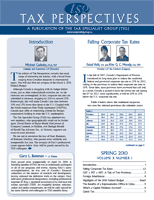
PDF Format
 Issue Contents Issue Contents
 All Issues All Issues
Spring 2010
Volume 10, Number 1
The information in Tax Perspectives is prepared for general interest only. Every effort has been made to ensure that the contents are accurate. However, professional advice should always be obtained before acting and TSG member firms cannot assume any liability for persons who act on the basis of information contained herein without professional advice.
What’s a Capital Dividend Account?
By Shelagh Rinald, CA, CFP, TEP
Rinald Tax Advisory Inc. (Victoria)
Although income flowing through a private company to its shareholders will generally be taxed twice — once when the company receives it and then again when the shareholders get it — Canada's Income Tax Act has various automatic provisions to reduce the total tax impact. But, when a corporation receives capital gains and insurance proceeds after the death of a shareholder, those need special attention if they're not to end up victims of double taxation. Using the capital dividend account (CDA) can help by permitting the company to distribute such income to its shareholders as tax-free dividends.
Calculating the CDA
The CDA includes:
- The non-taxable portion of the company's capital gains net of capital losses, which is currently 50% of the net capital gains (on donation of publicly traded shares, 100% of the gain is added to the CDA; do not donate shares with losses as the converse is also true).
- Any capital dividends the company receives from other companies.
- The non-taxable portion of any gains on the sale of eligible capital property, such as goodwill (added after the end of the tax year in which the gain is realized).
- Proceeds of life insurance policies on death.
- Distributions a trust may make to the company by paying out capital gains the trust has realized, or capitals dividends it has received.
After adding up these amounts to arrive at the CDA balance, that balance is reduced by the total of all capital dividends the company itself pays out.
A company may designate any dividend to be a capital dividend by filing a special election form and related documents with the CRA. If the election is not filed before or at the same time the dividend is paid, the CRA will impose a late-filing penalty of approximately $42 per month.
CDA Strategies
To make the best use of capital dividends, companies should consider the strategies briefly described below.
First, pay out the CDA as it accumulates. Because CDA created by capital gains will be eroded by capital losses, it would be a good idea to pay out capital dividends on a timely basis. Better still, if possible, realize the capital gains, pay out the CDA and then realize any capital losses.
Not all shareholders will benefit equally from capital dividends. For example, non-residents of Canada have to pay Canadian withholding tax and foreign tax on capital dividends just as if they were ordinary dividends. Charities and other tax-exempt entities, on the other hand, pay no tax. So, whether they receive capital dividends or ordinary dividends is irrelevant. It is best, therefore, to structure capital dividend distributions so that they are directed to the shareholders that will benefit the most from their tax-free nature.
Should a shareholder die holding shares of a company with a CDA, any capital gain realized on death may be reduced by having the company pay capital dividends within a year of the death. This is usually done with a corporate reorganization and share redemption sequence of transactions.
The proceeds of any company-owned insurance policy on the deceased will be added to the CDA, making such proceeds eligible for tax-free distribution. This can have significant estate planning advantages.
Another proactive approach to reducing death taxes is to first convert a shareholder's shares into "frozen" shares that do not participate in future growth, then reduce the inherent gains in those shares by allocating CDA via a share redemption to those frozen shareholdings.
It is important to note that, sometimes, there is uncertainty in determining the CDA balance. This could stem from concerns, for example, about whether property that has been sold triggers a capital gain (and thus an addition to CDA) or a trading gain.
Plan Carefully
The CDA can ease double taxation by allowing private companies to make a tax-free distribution to their shareholders of the untaxed portion of capital gains and life insurance proceeds they have received at the corporate level. The rules are, however, somewhat complex. Careful tax planning will help make the best use of the CDA.
| 






